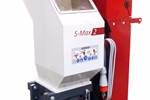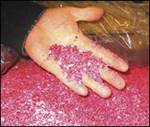Fighting Dust and Noise in Regrind Operations
Mayhew Basque Plastics implemented lower speed granulators to deal with challenging materials.
Mayhew Basque Plastics is a division of Mayhew Steel Products, a manufacturer of punches, chisels and other hand tools. In addition to molding the tool handles, the plastics division makes cable ties and custom-molded components for other products. The company’s injection molding operation uses PA66, glass-filled PA6 and glass-filled PP.

An operator feeds runner waste material into a press-side Wittman S-Max 3. Source: Mayhew Basque Plastics.
Mayhew operates granulators directly at press side, enabling operators to reintroduce regrind immediately back into the production process — but not without challenges over the years. The materials molded by Mayhew, with short cycle times, are very hot when they come out of the mold, which can impact grinding efficiency. In the past, Mayhew has used conventional high-speed, screened granulators and the company’s experience with nylon has been that it also generates high levels of dust when ground, necessitating a high frequency of cleaning tasks to keep the production environment clean and reduce risk to machinery.
“The problem with these materials is they get very dusty. Dust is hard on equipment. It gets into bearings. It gets everywhere,” says Lam Nguyen, general manager at Mayhew. In recent years, Mayhew has been incrementally replacing its granulators, working with Wittmann, as part of an effort to reduce dust and noise coming from its grinding operations.
Mayhew first trialed a screenless granulator design, the Wittmann S Max 3. The screenless technology cuts in a single pass, whereas in a screened granulator the granules remain in the cutting chamber and can potentially be cut multiple times before passing through. In Mayhew’s operation, it found that the screenless low-speed design produced regrind with minimal fines and significantly reduced dust. For some applications, it needed greater throughput, so it turned again to Wittmann, implementing the ML 33, a low-speed bladed granulator.
The ML 33 is a more conventional screened design but operates at a low rotor speed. The ML 33 also has an open rotor design that improves airflow to boost cooling, compared with a closed design. Mayhew has found that the granulator improves dust control while achieving the desired throughput capacity.
“We haven’t done any formal study to show this, but we know from the people who do the cleaning that we see less buildup on the machines, and we need to clean out the machines less often,” Nguyen says. “We’ve also found that the noise is greatly reduced when using a lower rpm.”
Mayhew Basque Plastics now operates 10 Wittmann granulators for its regrind operations, enabling the company’s closed loop process to maximize the value of excess material generated during injection molding.
Related Content
-
Five Quick Steps Toward Better Blending
Rising costs of resins and additives, along with higher demands for quality and use of regrind, place a premium on proficient blending. Here are some steps to get you there.
-
The Effects of Stress on Polymers
Previously we have discussed the effects of temperature and time on the long-term behavior of polymers. Now let's take a look at stress.
-
Fundamentals of Polyethylene – Part 6: PE Performance
Don’t assume you know everything there is to know about PE because it’s been around so long. Here is yet another example of how the performance of PE is influenced by molecular weight and density.
















